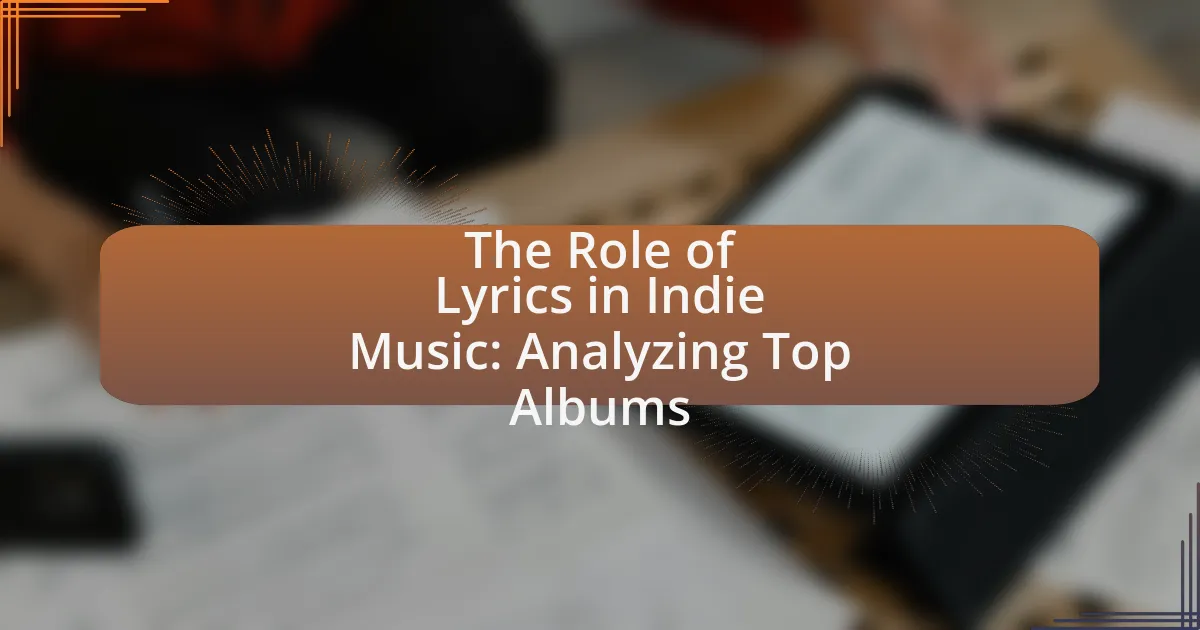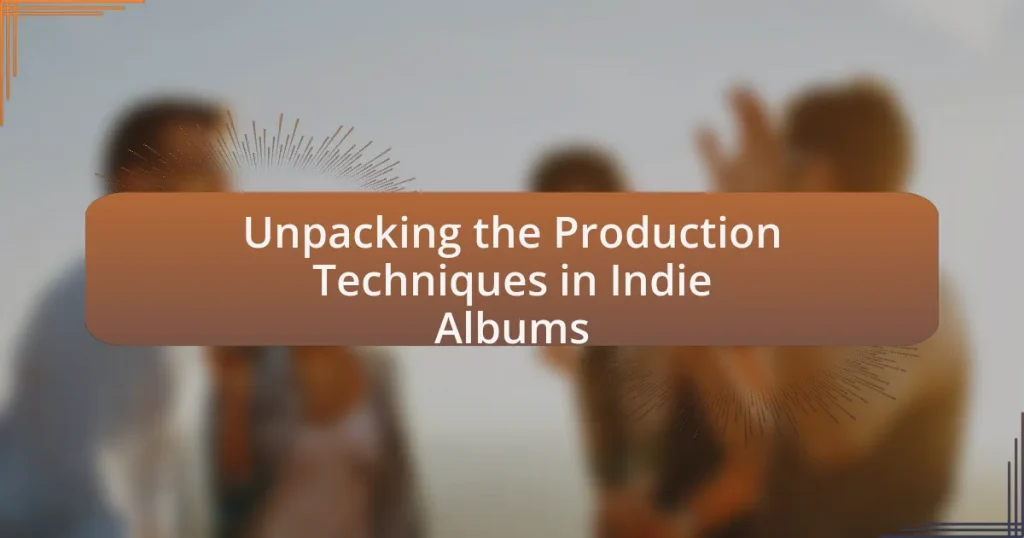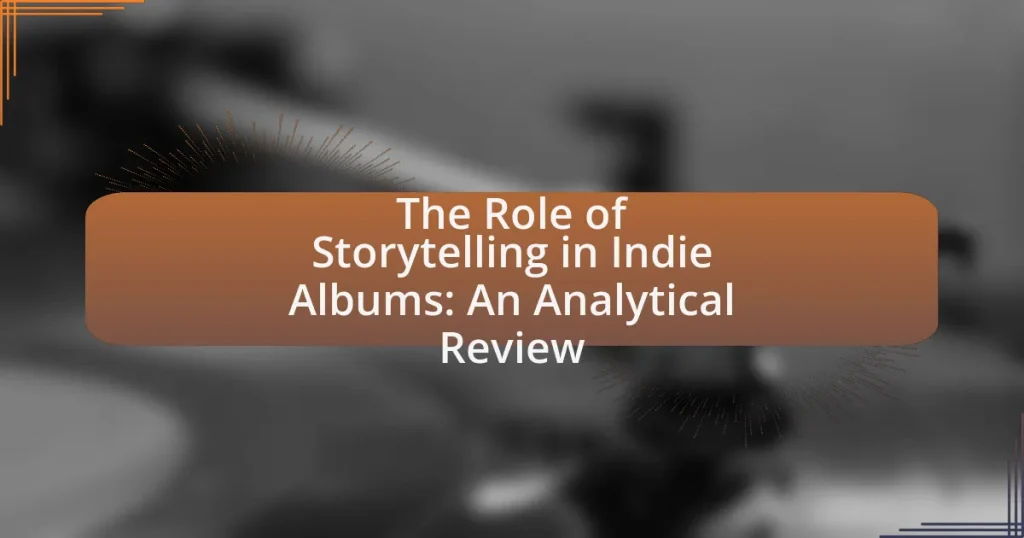The article examines the critical role of lyrics in indie music, emphasizing their function as a medium for personal expression and storytelling. It explores how lyrics influence the overall sound of indie music, the common themes found within them, and their emotional impact on listeners. Additionally, the article analyzes the characteristics of lyrics in top indie albums, the diverse lyrical styles among artists, and the methods for dissecting and understanding these lyrics. By highlighting notable examples and best practices for lyric writing, the article underscores the significance of lyrical content in shaping artist identity and fostering connections with audiences.

What is the Role of Lyrics in Indie Music?
Lyrics in indie music serve as a crucial medium for personal expression and storytelling, often reflecting the artist’s unique experiences and emotions. This genre prioritizes authenticity, allowing lyrics to convey deeper meanings and connect with listeners on an intimate level. For instance, artists like Sufjan Stevens and Phoebe Bridgers utilize introspective lyrics that explore themes of love, loss, and identity, which resonate strongly with their audience. The emphasis on lyrical content in indie music is supported by the genre’s roots in DIY culture, where artists often write and perform songs that reflect their individual perspectives, making the lyrics a fundamental aspect of their artistic identity.
How do lyrics influence the overall sound of indie music?
Lyrics significantly influence the overall sound of indie music by shaping the emotional tone and thematic content of the songs. The lyrical content often reflects personal experiences, social commentary, or abstract concepts, which in turn affects the musical arrangement, instrumentation, and vocal delivery. For instance, introspective and melancholic lyrics may lead to softer melodies and acoustic instrumentation, while more upbeat and playful lyrics can result in lively rhythms and energetic arrangements. This relationship is evident in albums like “The Suburbs” by Arcade Fire, where the lyrics explore themes of nostalgia and suburban life, influencing the orchestral and layered sound of the music. Additionally, studies have shown that lyrics can evoke specific emotional responses, which can guide the overall production choices in indie music, further solidifying the connection between lyrics and sound.
What themes are commonly explored in indie music lyrics?
Common themes explored in indie music lyrics include introspection, love, existentialism, and social commentary. Introspection often reflects personal struggles and self-discovery, while love can range from romantic to platonic relationships. Existentialism addresses questions of meaning and identity, frequently resonating with listeners seeking deeper understanding. Social commentary critiques societal norms and issues, providing a voice for marginalized perspectives. These themes are prevalent in notable indie albums, such as “The Suburbs” by Arcade Fire, which examines suburban life and identity, and “Carrie & Lowell” by Sufjan Stevens, which delves into personal loss and family dynamics.
How do lyrics contribute to the emotional impact of a song?
Lyrics significantly contribute to the emotional impact of a song by conveying relatable themes and personal narratives that resonate with listeners. The choice of words, imagery, and storytelling techniques in lyrics evoke specific feelings, allowing listeners to connect emotionally with the music. For instance, studies show that songs with vivid imagery and personal experiences tend to elicit stronger emotional responses, as they create a sense of intimacy and authenticity. This connection is further reinforced by the use of metaphors and similes, which enhance the emotional depth of the lyrics, making them more impactful.
Why are lyrics considered essential in indie music culture?
Lyrics are considered essential in indie music culture because they often serve as a primary means of personal expression and storytelling. In indie music, artists frequently prioritize authenticity and emotional depth, using lyrics to convey their unique perspectives and experiences. This focus on lyrical content distinguishes indie music from mainstream genres, where production and commercial appeal may overshadow the message. For instance, many acclaimed indie albums, such as “The Suburbs” by Arcade Fire, showcase intricate lyrics that explore themes of identity and societal issues, resonating deeply with listeners. This lyrical emphasis fosters a strong connection between the artist and the audience, reinforcing the cultural significance of lyrics within the indie music scene.
What role do lyrics play in artist identity and expression?
Lyrics serve as a fundamental component of artist identity and expression by conveying personal narratives, emotions, and cultural contexts. Through lyrics, artists articulate their beliefs, experiences, and perspectives, which helps to shape their unique identities within the music industry. For instance, artists like Phoebe Bridgers and Sufjan Stevens use introspective and often autobiographical lyrics to connect deeply with their audiences, reflecting their individual struggles and societal observations. This connection is evidenced by the critical acclaim and fan engagement that arises from their lyrical content, demonstrating how lyrics can enhance an artist’s authenticity and relatability.
How do lyrics foster connections between artists and listeners?
Lyrics foster connections between artists and listeners by conveying emotions, experiences, and narratives that resonate on a personal level. When artists express their thoughts and feelings through lyrics, they create a shared understanding that listeners can relate to, often reflecting their own life experiences. For instance, studies show that songs with relatable themes, such as love, loss, or social issues, can evoke strong emotional responses, enhancing the bond between the artist and the audience. This connection is further strengthened when listeners feel that the artist articulates their own feelings, leading to a sense of community and belonging among fans.

What are the Characteristics of Lyrics in Top Indie Albums?
The characteristics of lyrics in top indie albums often include introspective themes, emotional authenticity, and a focus on storytelling. These lyrics frequently explore personal experiences, societal issues, and existential questions, reflecting the artists’ unique perspectives. For instance, a study by the University of California found that indie lyrics tend to prioritize individuality and vulnerability, distinguishing them from mainstream pop music, which often emphasizes commercial appeal and broad relatability. Additionally, the use of metaphor and vivid imagery is prevalent, allowing listeners to engage with the music on a deeper emotional level.
How do lyrical styles differ among various indie artists?
Lyrical styles among various indie artists differ significantly in themes, language, and emotional expression. For instance, artists like Sufjan Stevens often employ intricate storytelling and personal narratives, while others like Phoebe Bridgers focus on introspective and confessional lyrics that explore mental health and relationships. Additionally, bands such as Vampire Weekend utilize clever wordplay and cultural references, contrasting with the raw and unfiltered approach of artists like Mitski, who convey deep emotional struggles through stark and poignant language. These differences reflect the diverse influences and backgrounds of indie artists, showcasing a wide range of lyrical creativity and expression within the genre.
What are some notable examples of unique lyrical approaches in indie music?
Notable examples of unique lyrical approaches in indie music include the storytelling techniques of Sufjan Stevens, who often weaves intricate narratives into his songs, as seen in the album “Illinois,” which explores themes of history and personal experience. Additionally, Phoebe Bridgers employs confessional and introspective lyrics that delve into mental health and relationships, particularly in her album “Punisher,” where she uses vivid imagery and emotional honesty to connect with listeners. Furthermore, the band The Decemberists is known for their literary references and historical storytelling, exemplified in their album “The Crane Wife,” which combines folklore with personal reflection. These artists demonstrate how innovative lyrical approaches can enhance the emotional depth and thematic complexity of indie music.
How do storytelling techniques manifest in indie lyrics?
Storytelling techniques in indie lyrics manifest through vivid imagery, personal narratives, and emotional depth. Indie artists often employ detailed descriptions and relatable experiences to create a strong connection with listeners, allowing them to visualize scenes and empathize with the emotions conveyed. For example, artists like Sufjan Stevens and Phoebe Bridgers utilize autobiographical elements and specific settings to enhance their storytelling, making their songs resonate on a personal level. This approach not only engages the audience but also reflects the broader themes of identity and introspection commonly found in indie music.
What impact do lyrics have on the reception of indie albums?
Lyrics significantly influence the reception of indie albums by shaping listeners’ emotional connections and interpretations. The depth, relatability, and storytelling within lyrics can enhance the overall experience, leading to greater appreciation and critical acclaim. For instance, albums like “The Suburbs” by Arcade Fire received widespread recognition partly due to their poignant lyrics that resonate with themes of nostalgia and societal critique. This connection often translates into higher sales and streaming numbers, as evidenced by the album’s Grammy Award for Album of the Year in 2011. Thus, the quality and content of lyrics play a crucial role in how indie albums are perceived and valued by audiences and critics alike.
How do critics evaluate lyrics when reviewing indie music?
Critics evaluate lyrics in indie music by analyzing themes, emotional depth, and originality. They assess how well the lyrics convey personal experiences or societal commentary, often looking for authenticity and relatability. For instance, critics may highlight the use of metaphor and imagery, which can enhance the emotional impact of a song. Additionally, they consider the lyrical structure and how it complements the music, as seen in albums like “Carrie & Lowell” by Sufjan Stevens, where introspective lyrics are paired with minimalist instrumentation to create a poignant listening experience. This evaluation process is crucial in indie music, where lyrics often play a central role in defining the artist’s identity and connecting with the audience.
What role do lyrics play in shaping fan interpretations of albums?
Lyrics play a crucial role in shaping fan interpretations of albums by providing thematic context and emotional resonance. Fans often analyze lyrics to derive meaning, connect personal experiences, and engage with the artist’s narrative. For instance, in albums like “The Suburbs” by Arcade Fire, the lyrics explore themes of nostalgia and suburban life, prompting fans to reflect on their own backgrounds and societal issues. This interpretative process is supported by studies indicating that lyrical content significantly influences listeners’ emotional responses and overall album appreciation, as seen in research published in the Journal of Popular Music Studies, which highlights the relationship between lyrical themes and listener engagement.

How Can We Analyze Lyrics from Top Indie Albums?
To analyze lyrics from top indie albums, one can employ thematic analysis, which involves identifying recurring themes, motifs, and emotional tones within the lyrics. This method allows for a deeper understanding of the artist’s intent and the cultural context surrounding the music. For instance, examining the lyrics of albums like “In the Aeroplane Over the Sea” by Neutral Milk Hotel reveals themes of loss and nostalgia, which are prevalent in indie music. Additionally, utilizing tools such as lyric databases and software for sentiment analysis can quantify emotional content, providing further insights into the lyrical landscape. This approach is supported by studies that highlight the significance of lyrical content in shaping listener experiences and interpretations in the indie genre.
What methods can be used to dissect lyrics in indie music?
Methods to dissect lyrics in indie music include thematic analysis, lyrical content analysis, and contextual interpretation. Thematic analysis involves identifying recurring themes and motifs within the lyrics, which can reveal the artist’s message and emotional tone. Lyrical content analysis focuses on the structure, word choice, and literary devices used, allowing for a deeper understanding of the artistic techniques employed. Contextual interpretation examines the cultural, historical, and personal background of the artist, providing insight into how these factors influence the lyrics. These methods are supported by academic frameworks in musicology and literary studies, which emphasize the importance of both textual and contextual analysis in understanding artistic expression.
How do lyrical analysis techniques enhance our understanding of songs?
Lyrical analysis techniques enhance our understanding of songs by providing insights into themes, emotions, and cultural contexts embedded within the lyrics. These techniques, such as close reading, thematic analysis, and structural analysis, allow listeners to dissect the language, imagery, and narrative techniques used by songwriters. For instance, close reading can reveal how specific word choices evoke particular feelings or convey complex ideas, while thematic analysis can identify recurring motifs that reflect societal issues or personal experiences. Research indicates that understanding these elements can deepen listeners’ emotional connections to the music and foster a greater appreciation for the artistry involved in songwriting.
What tools are available for analyzing lyrics in-depth?
Tools available for analyzing lyrics in-depth include software and platforms such as Genius, which provides annotations and interpretations of song lyrics, and LyricFind, which offers a comprehensive database of lyrics with search capabilities. Additionally, tools like RhymeZone assist in analyzing rhyme schemes and patterns, while text analysis software such as Voyant Tools can perform sentiment analysis and word frequency counts on lyrics. These tools enable users to explore lyrical themes, structures, and meanings, enhancing the understanding of the role of lyrics in indie music.
What are some key examples of impactful lyrics in top indie albums?
Key examples of impactful lyrics in top indie albums include “Skinny Love” by Bon Iver, which explores themes of heartbreak and longing, and “The Night We Met” by Lord Huron, reflecting on nostalgia and lost love. In “Take Me Out” by Franz Ferdinand, the lyrics convey urgency and desire, while “Dog Days Are Over” by Florence + The Machine celebrates liberation and self-discovery. These songs have resonated widely, evidenced by their critical acclaim and commercial success, showcasing the emotional depth and storytelling capabilities of indie music.
How do specific lyrics resonate with listeners on a personal level?
Specific lyrics resonate with listeners on a personal level by reflecting their emotions, experiences, and identities. This connection occurs because lyrics often articulate feelings and situations that individuals have encountered, creating a sense of validation and understanding. For instance, studies show that music with relatable themes can enhance emotional responses, leading to increased engagement and personal reflection. Research published in the Journal of Personality and Social Psychology indicates that lyrics that evoke personal memories can significantly impact listeners’ emotional states, reinforcing the idea that specific phrases or narratives can mirror personal journeys and struggles.
What lessons can be learned from the lyrical content of successful indie albums?
Successful indie albums often convey themes of authenticity, emotional vulnerability, and personal storytelling. These elements resonate with listeners, as they create a genuine connection through relatable experiences. For instance, albums like “For Emma, Forever Ago” by Bon Iver showcase introspective lyrics that explore heartbreak and solitude, which have contributed to its critical acclaim and commercial success. Additionally, the use of vivid imagery and metaphor in lyrics, as seen in “The Suburbs” by Arcade Fire, allows for deeper emotional engagement and reflection, further enhancing the album’s impact. Thus, the lyrical content of successful indie albums teaches the importance of sincerity, emotional depth, and the power of storytelling in music.
What best practices can artists follow when writing lyrics for indie music?
Artists writing lyrics for indie music should focus on authenticity, storytelling, and emotional resonance. Authenticity ensures that the lyrics reflect the artist’s true voice and experiences, which resonates with listeners. Storytelling engages the audience by creating vivid imagery and relatable narratives, often drawing from personal or observational experiences. Emotional resonance connects the audience to the song, evoking feelings that enhance the listening experience.
For instance, many successful indie artists, such as Sufjan Stevens and Phoebe Bridgers, utilize personal anecdotes and introspective themes in their lyrics, which have contributed to their popularity and critical acclaim. This approach not only establishes a unique artistic identity but also fosters a deeper connection with the audience.



